Understanding Rare Con is just one article: what other expandable gameplay is there?
What other gameplay can be expanded beyond Rare Con besides this one article?Original author: Jaleel, cookie Translator: Blockbeat
On the morning of May 23, a new Sats was born with the number 8669069, causing a sensation in the Ordinals community. The reason this particular Sats received so much attention is that it is the first Rare-level rare Sats inscription. Rare-level rare Sats are the first Sats of the difficulty adjustment period, and out of 19 trillion Sats, there are only 369 rare-level rare Sats!
Interestingly, this rare Sats inscription was also engraved with a special image, “The Times 03/Jan/2009 Chancellor on brink of second bailout for banks.” This headline from a London Times article that was once engraved by Satoshi Nakamoto in the Genesis block is also engraved in the inscription image of the first Rare-level rare Sats. The eye-catching number of the rare Sats, 8669069, combined with the image of special significance, seems to elevate the rarity of this special Sats to another level.
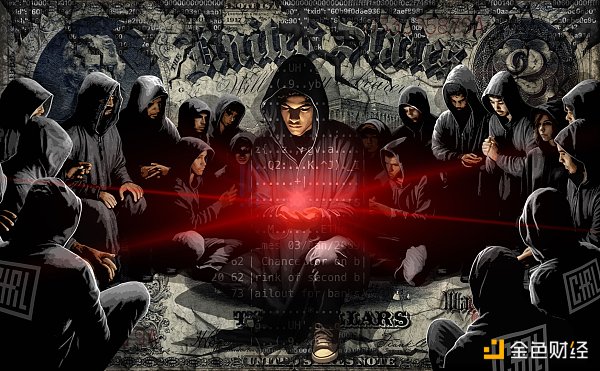
- Understanding Consensus Mechanism and 11 Popular Consensus Algorithms in One Article
- Summary of the 162nd Ethereum Execution Layer core developer meeting: The reasonable target time for the Cancun upgrade is October.
- Explaining Futures Contracts in Contango: Low and Predictable Costs
We are all Sats, why am I rarer than you?
Bitcoin adopts a UTXO-based transaction model, and each transaction output has an index, which can be located to a specific output by transaction hash and index. People are naturally inclined to collect, and this also applies to Bitcoin. The unit of composition of Bitcoin is Sats, and each Bitcoin is composed of 100 million Sats. Since every Sats in Bitcoin can be traced and transferred, people want to collect them. The scarcity and specialness of Sats can be determined by ordinal theorists themselves, which gives Sats special meaning. Whether it’s a Bitcoin mined by Satoshi Nakamoto, or the first Sats of a certain block, or the Sats used to buy pizza, the Sats contained in these transactions have special significance.
The Ordinals protocol provides a unique number for Sats, and each Sats has its own digital identifier. This numbering system allows Sats to be clearly distinguished and tracked. Bitcoin has a series of periodic events, some of which occur frequently and some of which are relatively rare, which naturally form a rare system. The current periodic events are:
1. Block mining: From now until the end of time, a new block will be mined approximately every 10 minutes. This periodic event is the basic unit in the Bitcoin network, providing security and confirmation for transactions.
2. Difficulty adjustment: Every 2016 blocks, or roughly every two weeks, the Bitcoin network responds to changes in hash rate by adjusting block difficulty to ensure a relatively stable mining speed for Bitcoin.
3. Halving: Every 210,000 blocks, or roughly every four years, the amount of new Bitcoin produced in each block in the Bitcoin network is halved. This event reduces the supply of Bitcoin, making it scarce and inflation-resistant.
4. Cyclic convergence: Something magical happens after six halvings. Halving and difficulty adjustment occur simultaneously, forming a so-called convergence. The time period between convergences is one cycle, and a convergence occurs approximately every 24 years. It is predicted that the first convergence should occur sometime in 2032.
These periodic events give each satoshi a unique identity and attributes. Based on these cyclical events, the Ordinals document defines the rarity of satoshis into several levels. The total and current supply of these rarities can also be calculated based on the number of satoshis mined:
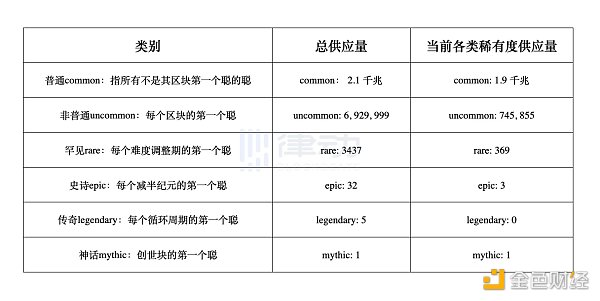
Not only rare, but also interesting
In addition to rare satoshis, there is also a class of intriguing “fun” satoshis. Each satoshi has a name composed of the letters A to Z, and the longer the satoshi has been mined, the shorter its name becomes. They can start short and then get longer, so all good, short names are trapped in the unusable genesis block. For example, the name of 1905530482684727° is “iaiufjszmoba”. The name of the last mined satoshi was “a”. Every combination of 10 or fewer characters exists, or will exist someday.
In addition to their name or rarity, satoshis may also be valued for other reasons. For example, because of the nature of the numbers themselves, especially those with integer square or cube roots. For example, the satoshi (SegWit activation block) from block 477,120 is 2099999997689999°, which is the last satoshi to be mined. Also popular are palindromic satoshis, which are satoshis whose digits or letters read the same backward as forward. They have a symmetrical beauty in the arrangement of their digits and letters.
There are some special narratives that are exclusive to Bitcoin, related to a certain historical event of Bitcoin. In the early history of Bitcoin, there was a landmark story that was widely circulated, which was that someone used Bitcoin to buy two pizzas. This story happened on May 22, 2010, when the price of Bitcoin was still very low and almost negligible. At that time, a Bitcoin enthusiast posted a post on the Bitcoin forum, asking if anyone would be willing to buy pizza with Bitcoin. He proposed that for the price of two pizzas, the paid person would receive 10,000 Bitcoins.
This post caught the attention of the community and a enthusiastic Bitcoin holder responded to the request. He contacted a local pizza shop and arranged a transaction of 10,000 Bitcoins. This transaction became the first real transaction in the history of Bitcoin, and is also known as the “Pizza transaction” of Bitcoin. The value of 10,000 Bitcoins was almost worthless in dollars, but today the value of this number of Bitcoins has reached billions of dollars.
The story of this pizza transaction has aroused widespread attention and discussion in the Bitcoin community, and May 22 is also known as “Bitcoin Pizza Day”, becoming a unique part of Bitcoin’s history. The Satoshi in this transaction also appears as “Pizza Satoshi”. This seemingly ordinary pizza transaction has now become a landmark event in the history of Bitcoin, symbolizing Bitcoin’s huge value growth from its simple exchange at birth to the present.
In addition, there are also some Satoshis in the Bitcoin world that have not been traded. From a regulatory perspective, Satoshis that have not been traded are guaranteed their purity because they have not been involved in the black market. These Satoshis seem to have been stored in Bitcoin wallets and have not been used or transferred. There are various speculations and hypotheses about these untraded Satoshis. Some people think that they may be a legacy of early Bitcoin miners, or Satoshis that have been permanently sealed due to lost passwords. These untraded Satoshis have become a mystery in the world of Bitcoin, arousing people’s curiosity and research interests.
The Silk Road incident and the Mt. Gox incident, which are also part of Bitcoin’s history, have some organizations that are specifically mining rare Satoshis, and have begun to mine Satoshis related to them. The Silk Road was a famous black market trading platform, while the Mt. Gox incident refers to a Bitcoin developer who was highly concerned about losing access to his own Bitcoin Satoshis. These early Bitcoin involvements have prompted people to think about the history and value of Bitcoin, and have also promoted in-depth exploration of the development and evolution of Bitcoin.
What other expandable gameplay options are there?
On May 26th, the @RareSatSociety community engraved a rare Satoshi with five attributes: Uncommon + Nakamoto + Block 78 + First tx + Pizza, with a serial number of 9164772, which caused a hot discussion. The community believes that the value of multi-attribute rare Satoshi is more than just doubling.
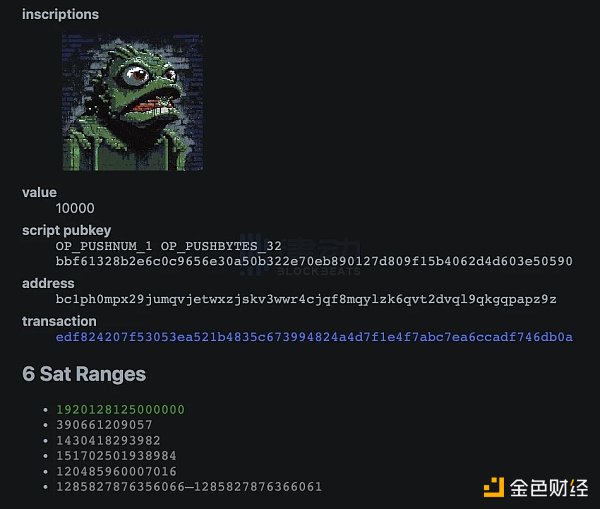
As the community with the most rare Satoshis in stock, the Rare Satoshi Society community also released the “.sats” member pass, which will receive exclusive access to gifts, white lists, and other things from well-known figures in the Alpha and Ordinals domains. SatsHunters, a project that seeks rare Satoshis for individuals or projects, has released a Taproot Collection consisting of 1138 unique images, holders of which can access various early project functions. At present, there are also many projects that deploy tokens on rare Satoshis.
Project Nullish will engrave rare Satoshis with Uncommon Blockingtterns to create art collections. These 50 pieces are arranged by the age of the Satoshi and are sold through Gamma’s PSBT (partially signed Bitcoin transaction). These 50 uncommon patterns are all in the top 100 rare inscriptions of Bitcoin, as well as in the fully on-chain renderer, accounting for 51% of the rare inscriptions outside the top 100.
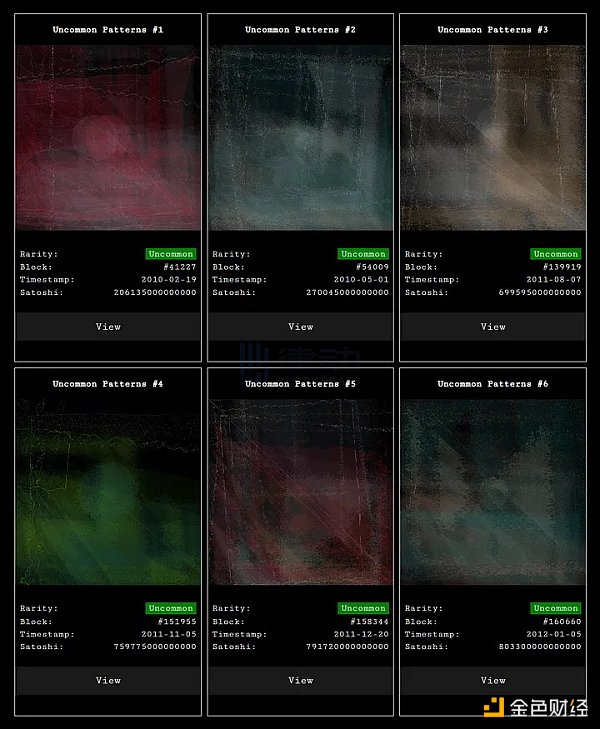
The Gamma auction framework is also interesting. The auction is based on PSBT technology (partially signed Bitcoin transaction) and all prices start at 0.5 BTC and drop to 0.05 BTC within 3 days. Every 18 blocks (3 hours), the price of all collectibles that can still be auctioned will drop by 0.01875 BTC. Each block takes about 10 minutes, and the auction will continue until the Bitcoin Miami Conference in 2023 (May 18th to 20th), which has ended.
At the same time, Gamma has also recently pioneered a trustless method where users pre-sign transactions at price points they are willing to buy and connect to collectors’ demands through a trustless Dutch auction: If a user is willing to buy at a price of 0.1 BTC, they can pre-sign the transaction and bid at a price of 0.1 BTC. When the price of the Dutch auction drops to 0.1 BTC and there are no higher bids, the transaction will be broadcasted.
The innovation brought by Gamma allows users to set their bids at specific prices and come back later to see if they are still the highest bidder. The transaction signed by the bidder is valid within the price drop point of the auction and is only valid in the expected specific blocks. This means that the Bitcoin signed by the user will not be moved out of the wallet until the price drops to the bid amount.
Currently, some KOLs are planning to expand gameplay by creating a collection of 100 or more NFTs, all of which will be engraved on Uncommon-level Cones. A group purchase of a certain quantity of rare cones is required, with the buyer responsible for GAS. Unlike Nullish’s collection, the design of the engraved images will be decided in a DAO-like manner. The approximate value of an engraved rare cone can be determined by looking at the floor price on Magic Eden, which is currently around 0.5 BTC or about 1500 U. Although the exact value of an engraved rare cone cannot be determined at this time, most community members believe that engraving a set of images onto rare cones will be more valuable than simply retaining a single rare cone.
In addition, a website that allows you to check if you have rare cones in your wallet will soon have an extraction and transfer function, and more derivative products based on rare cones may be introduced in the future, creating new gameplay opportunities.
New player entry guide
As mentioned above, the Nullish project will sell rare cones engraved with Uncommon Blockingtterns to create art collections through PSBT (partially signed Bitcoin transactions) on Gamma. Additionally, Gamma has listed a collection of rare cones engraved with images, as shown in the following figure. New players who want to participate in rare cones, want to save time, and happen to appreciate this art collection can consider this option.
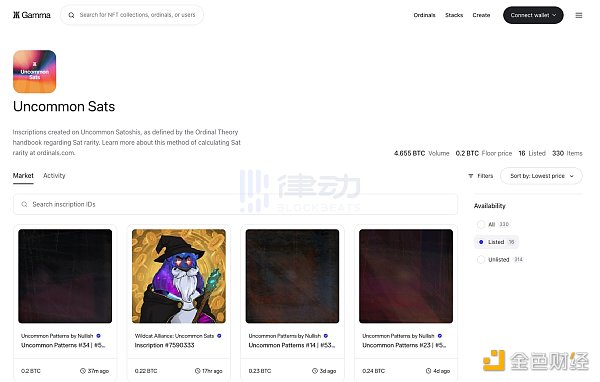
In the search address mentioned above, you can check if you have rare cones in your wallet. If you find rare cones in your wallet that you want to engrave or sell, the operation steps are quite complicated. Engraving requires the use of a full node, and selling requires first splitting the UTXOs and then adding money to the newly split UTXOs.
KOL999.btc has provided a detailed tutorial on how to extract rare cones on their Twitter account, but BlockBeats would like to emphasize some precautions: before formally extracting rare cones, we need to prepare two receiving addresses, one for receiving UTXOs containing rare cones, and the other for receiving UTXOs not containing rare cones.
Additionally, it is best to use Taproot-formatted receiving addresses throughout the entire operation. Taproot is a 2021 upgrade to Bitcoin that improves security, adds new features, and increases privacy. However, Taproot was only widely adopted when Ordinals appeared. Bitcoin is always backward compatible, but sometimes when adding new features, only wallets that integrate these upgrades can use them. Technically, the correct term for a “Taproot address” is a “Bech 32 m address,” and Taproot addresses are easily recognizable because they start with “bc 1” as the prefix.
For new players who do not have rare satoshis in their wallet, where can they buy unrecorded rare satoshis? Nullish lists the prices of rare satoshis they sell in the official market of Gamma. Depending on the year (timestamp) and rarity, the actual circulation varies and the price also varies. As of now, the price of Uncommon rare satoshis in 2023 is 0.05 BTC, in 2022 is 0.065 BTC, in 2013 is 0.1 BTC, in 2011 is 0.11 BTC, in 2010 is 0.15 BTC, and in 2009 is 0.3 BTC.
However, most of the rare satoshis found by Nullish are not circulating for sale, such as the rare satoshis in 2009, because they are the rarest and there were not many of them, and many of them cannot be found anymore. Currently, most of the unscribed rare satoshis for sale are from 2023, so the floor price for unscribed rare satoshis is currently 0.05 BTC.
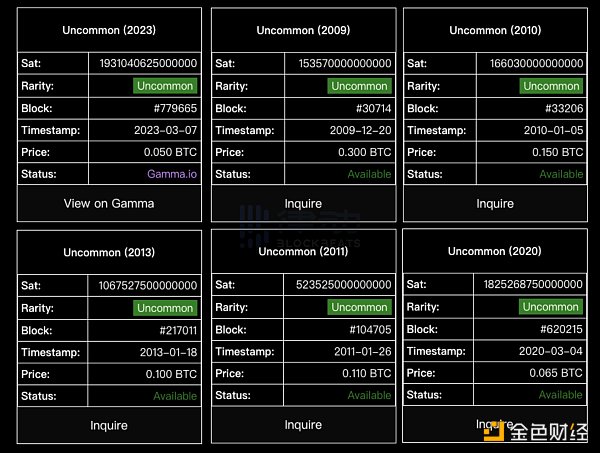
For satoshis that are old or have not been recorded, the RSSC community can currently support OTC, and users can go to the RSSC community’s Discord to find the Cofounder to guarantee the transaction.
Block 78, which has been very popular recently, is the first block mined by someone other than Satoshi Nakamoto. It originally belonged to the late cypherpunk Hal Finney, who was the first person other than Satoshi Nakamoto to begin mining Bitcoin and the only person to receive transactions directly from him. Block 78 was the first block Hal ever mined, and at around the same time, he tweeted the first tweet about Bitcoin:
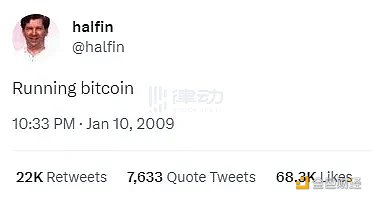
Based on the information collected so far, someone in the want to sell channel of the RSSC Discord community gave a price of around 1 dollar for one satoshi of Block 78. Also, if you want to engrave a picture on a rare satoshi, you can use the Ordinalsbot tool to directly select the picture to be engraved on the rare satoshi, but the inventory of rare satoshis is not always available and needs to be watched for a while. Blockbeats reminds that the floor price of 0.05 BTC for rare satoshis may be too high and may face some potential risks. The article mentions that all projects do not constitute investment advice.
Reference:
Ordinal Theory Handbook: https://docs.ordinals.com/introduction.html
Chinese version of Ordinal Theory Handbook: https://www.ordinalscn.org/
We will continue to update Blocking; if you have any questions or suggestions, please contact us!
Was this article helpful?
93 out of 132 found this helpful
Related articles
- How has Sui mainnet performed after being online for 3 weeks? A article interpreting its data and community sentiment.
- Analysis of the Characteristics, Development Status, and Prospects of Solana’s Three Major NFT Lending Protocols
- Data Analysis of Ordinals NFTs: Blue Chip Index (2023/5/25)
- Potential Black Swan? What will happen to BTC and ETH in the event of a US debt default?
- DCG announces the closure of TradeBlock: the end of an era?
- Variant Fund’s thoughts on the future development of SocialFi: How to build it?
- Removing the official website’s cryptocurrency description and entering the field of AI, what paradigm shift is Blockingradigm undergoing?






